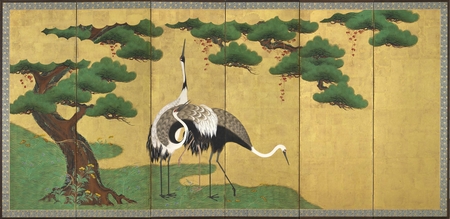Product Description
6782 A six -fold paper screen painted in ink and colour on a gold ground with three tsuru (cranes). The birds are standing upon grass scattered with wild flowers, beneath a matsu (pine) and tsuta (Japanese ivy). The red leaves of the ivy denote that the season is late autumn.
Japan 19th century Meiji/Taishō period
Dimensions: H. 53¼” x W. 108″ (135cm x 274cm)
Tsuru (cranes) are among the premier symbols of longevity and good fortune in East Asia. For at least two millennia, the Chinese have viewed them as living to a great age and as being able to navigate between heaven and earth. In turn, these attributes have made them logical companions of sennin, the Taoist Immortals. Ancient Taoist alchemists believed that imbibing beverages made with crane eggs or tortoise shells would increase one’s vital energies.
In Japan, the crane is the animal most frequently seen in the fine and applied arts. Although a common subject of painting, it is most closely associated with the New Year and with marriage ceremonies. In earlier times, when the Japanese still used circular brass mirrors and presented them on the occasion of a marriage, the crane was a favoured decorative theme due to its association with fidelity. In recent centuries, the crane has appeared on elaborately embroidered wedding kimono and among the mizuhiki (cord made from twisted paper) decorations presented at the time of betrothal.
The matsu (pine tree) holds a prominent role in Japanese art, largely due to its auspicious associations which were originally adopted form Chinese traditions. This evergreen has long been seen as a symbol of longevity, steadfastness and good fortune due to its ability to remain green and fresh even during the fiercest of winters. Furthermore, in Japan the pine has always been prized for its practical uses, and its attractive appearance lends itself to being creatively represented in both painting and design. Along with the plum and bamboo, the pine is also one of the shōchikubai (pine-bamboo-plum) or saikansanyū (three friends of winter) which is a popular theme in Japanese art.
Tsuta (Japanese ivy) has long been used as a design motif and is praised in Japanese literature for its beauty. In art its appearance can allude to the tsuta no hosomichi (lit. narrow road of ivy), made famous in episode 9 of Ise Monogatari (Tales of Ise). In this scene the hero who is often identified as Ariwara no Narihira (825-880) is travelling to Mt Utsu and encounters a narrow passage overgrown by ivy and maples. Here he meets a wandering ascetic headed back towards the capital and entrusts him with a message for a lady there.
‘On and on they went until they reached Suruga Province and came to Mount Utsu. The path across it was very dark and narrow, overgrown with ivy and maples, and they were feeling depressed about their situation when they met an ascetic. “What are you doing here, on a path like this?” he asked. The man recognised him. He wrote a letter for the ascetic to take to his loved one in the Capital:
Suruga naru
Utsu no yamabe no
utsutsu ni mo
yume ni mo hito ni
awanu narikeri
Where in Suruga
rise the flanks of Mount Utsu,
neither the senses
nor dreams ever gladden me
with the presence of my love’
(Tales of Ise, excerpt from episode 9, translated by Joshua Mostow and Royall Tyler)
The poem above plays on the name of Mt. Utsu, since it resembles the word utsutsu meaning ‘consciousness’. It was a popular belief that your lover would appear in your dreams when they thought of you. Therefore, with this poem the hero is in fact noting his insecurity and fear that he may no longer be in the thoughts of his lover left behind in the capital.






